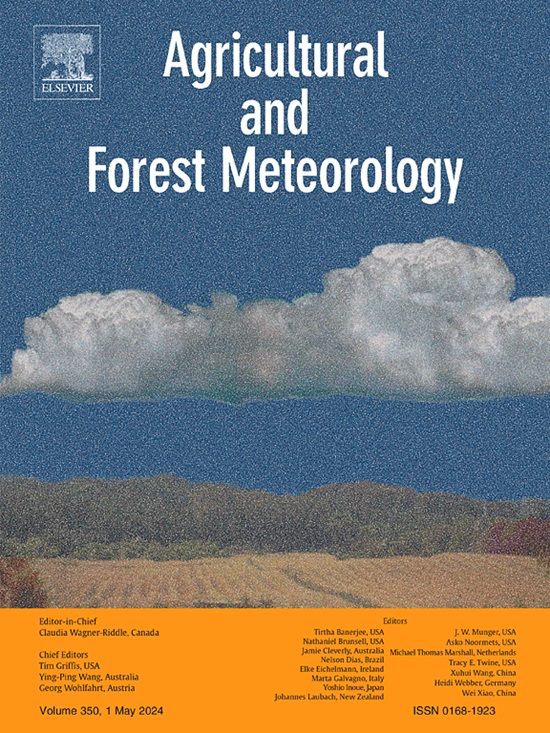The value of small urban green spaces in mitigating urban heat: a fine-grained nationwide analysis
IF 5.7
1区 农林科学
Q1 AGRONOMY
引用次数: 0
Abstract
Urban green spaces (UGS) are increasingly recognized as vital nature-based solutions for mitigating urban heat, particularly against a background of accelerating urbanization, anthropogenic warming, and intensifying heatwaves. However, small UGS (<1 ha) have long been undervalued in cooling strategies due to their fragmented distribution and presumed limited cooling capacity. Here, we conducted a comprehensive assessment of the multi-dimensional cooling effects of 60,064 UGS—ranging from 0.1 ha to 200 ha— across 36 major Chinese cities during the summer of 2020. The key findings are as follows: (1) Although small UGS comprise only 11.31 % ± 4.78 % of the total UGS area, they dominate in patch number (71.97 % ± 8.29 %) and contribute disproportionally to multi cooling effects, including cooling area (50.62 % ± 10.18 %), cooling intensity (55.36 % ± 9.8 %), cumulative cooling (64.96 % ± 8.85 %), cooling gradient (60.96 % ± 9.52 %), cooling area efficiency (94.42 % ± 1.99 %), and cooling intensity efficiency (94.91 % ± 1.95 %). (2) The cooling performance of small UGS is predominantly influenced by anthropogenic factors, with higher built-up and road areas enhancing their localized “urban oasis” effect. (3) The threshold values of cooling intensity efficiency (0.49–0.63 ha) and cooling area efficiency (12.38–19.90 ha) increase progressively from medium cities to megacities, correlating significantly correlations with urbanization factors. Meanwhile, these thresholds are a 6–24 % lower than those estimated without considering small UGS, suggesting the existence of diseconomy of greening for heat mitigation by ignoring small UGS. (4) Finally, six distinct clusters of cooling service bundles were identified, each characterized by distinct landscape characteristics, providing a framework for more tailored UGS planning and management strategies in diverse urban settings. These findings highlight the crucial role of small UGS in urban thermal mitigation and provide actionable ecological knowledge to enhance urban cooling efficiency towards sustainable cities and society.
城市小绿地在城市降温中的价值:一项细粒度的全国分析
城市绿地(UGS)越来越被认为是缓解城市热量的重要自然解决方案,特别是在城市化加速、人为变暖和热浪加剧的背景下。然而,由于其分散分布和假定的有限冷却能力,小型UGS(1公顷)长期以来在冷却策略中被低估。在这里,我们对2020年夏季中国36个主要城市60,064个ugs的多维冷却效果进行了综合评估,范围从0.1 ha到200 ha。主要结论如下:(1)虽然小UGS组成只有11.31%±UGS总面积的4.78%,他们主宰补丁(71.97%±8.29%)和贡献不成比例地数量多冷却效果,包括冷却面积(50.62%±10.18%),冷却强度(55.36%±9.8%),累计冷却(64.96%±8.85%),冷却梯度(60.96%±9.52%),冷却面积效率(94.42%±1.99%),冷却强度效率(94.91%±1.95%)。(2)小型地下水库的降温性能主要受人为因素影响,较高的建成区和道路面积增强了其局部“城市绿洲”效应。③从中等城市到特大城市,冷却强度效率(0.49 ~ 0.63 ha)和冷却面积效率(12.38 ~ 19.90 ha)的阈值逐渐增大,且与城市化因素呈显著相关。与此同时,这些阈值比不考虑小型UGS的估计值低6 - 24%,表明忽略小型UGS的绿化减热存在不经济性。(4)最后,确定了6个不同的冷却服务束集群,每个集群都具有不同的景观特征,为不同城市环境下的UGS规划和管理策略提供了框架。这些发现强调了小型UGS在城市热缓解中的关键作用,并提供了可操作的生态知识,以提高城市冷却效率,实现可持续的城市和社会。
本文章由计算机程序翻译,如有差异,请以英文原文为准。
求助全文
约1分钟内获得全文
求助全文
来源期刊
CiteScore
10.30
自引率
9.70%
发文量
415
审稿时长
69 days
期刊介绍:
Agricultural and Forest Meteorology is an international journal for the publication of original articles and reviews on the inter-relationship between meteorology, agriculture, forestry, and natural ecosystems. Emphasis is on basic and applied scientific research relevant to practical problems in the field of plant and soil sciences, ecology and biogeochemistry as affected by weather as well as climate variability and change. Theoretical models should be tested against experimental data. Articles must appeal to an international audience. Special issues devoted to single topics are also published.
Typical topics include canopy micrometeorology (e.g. canopy radiation transfer, turbulence near the ground, evapotranspiration, energy balance, fluxes of trace gases), micrometeorological instrumentation (e.g., sensors for trace gases, flux measurement instruments, radiation measurement techniques), aerobiology (e.g. the dispersion of pollen, spores, insects and pesticides), biometeorology (e.g. the effect of weather and climate on plant distribution, crop yield, water-use efficiency, and plant phenology), forest-fire/weather interactions, and feedbacks from vegetation to weather and the climate system.

 求助内容:
求助内容: 应助结果提醒方式:
应助结果提醒方式:


